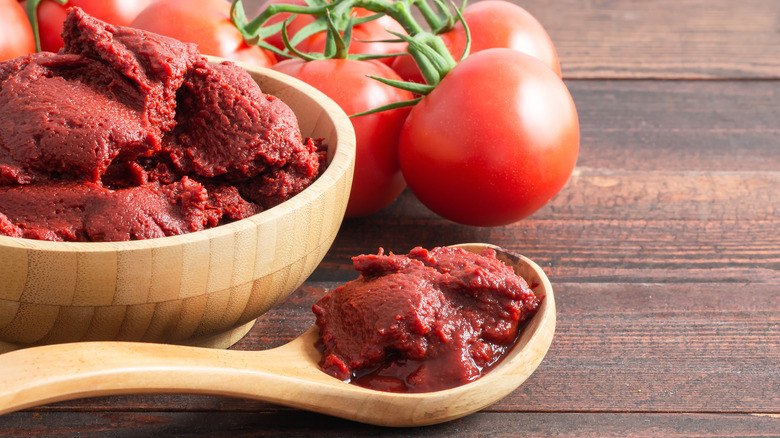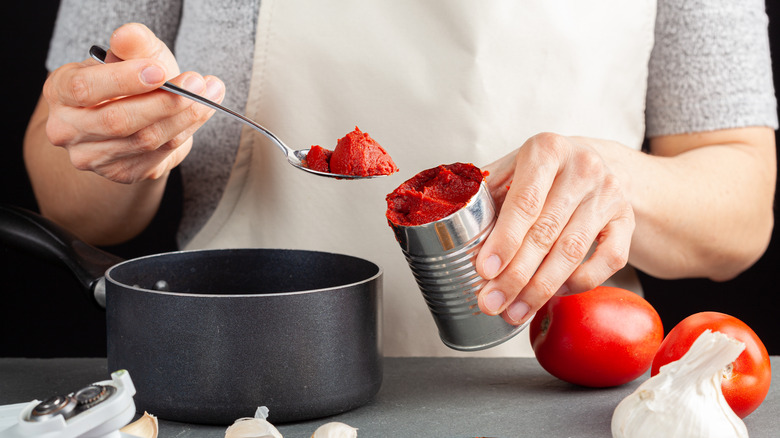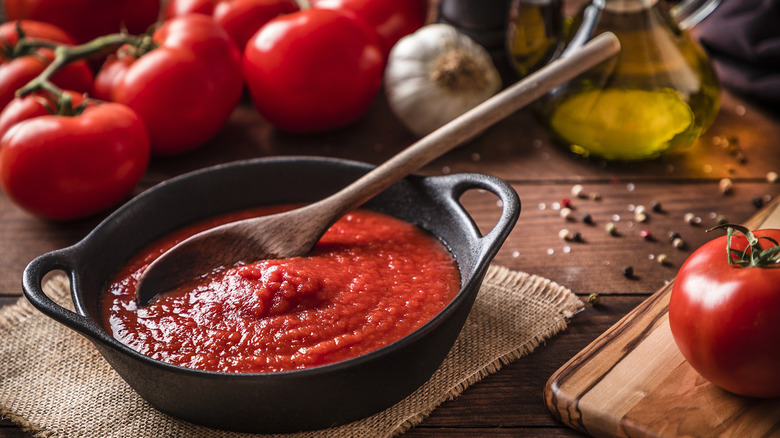The Difference Between Tomato Paste In A Tube Vs A Can
Whether you're making an easy weeknight marinara, or planning to slow simmer a Sunday night Bolognaise, chances are the recipe calls for a few tablespoons of tomato paste. This versatile condiment is different from tomato sauce. It's made by cooking tomatoes down until all of the water has evaporated and all that's left is just pure, rich, cooked tomato essence. It packs a ton of flavor into a small container, and it's a solid shortcut when you don't have all day to simmer your grandma's pasta sauce recipe. You've probably noticed, however, that tomato paste comes either in a tiny can or in a metal tube that looks like toothpaste. Both canned and tubed tomato paste can be used pretty interchangeably, but they do have some distinct differences.
Cans and tubes of tomato paste have advantages and disadvantages, and it all comes down to how they're made and preserved. Paste in a can is often cooked at a slightly different temperature than paste in a tube, and it's preserved with citric acid. Paste in a tube, on the other hand, is cooked at a lower temperature and preserved with salt, so it can have a different color and taste. The stuff in the tube is also often double-concentrated.
Tomato paste: Can vs tube
Tomato paste is a product that proves that good things come in small packages. It's sold in very small cans or tubes, which tend to contain around 9 or 10 tablespoons of paste. Think of it sort of like the demi-glace of tomato sauce.
Canned tomato paste is more common in the United States, mostly because that's how it's commonly made here. The paste is cooked at 200 degrees Fahrenheit, which caramelizes the naturally occurring sugars in the tomatoes and gives the paste a darker color. The paste is then mixed with citric acid to preserve it, which gives the paste a slightly tart flavor.
Tomato paste in the tube, on the other hand, is almost always made in Italy (even the store-brand versions, just check the label). Over there, tomato paste is cooked at 150 degrees Fahrenheit, which gives the paste a brighter red color and a looser texture. Paste in a tube is then preserved with salt before it's packaged, which gives it a different flavor than paste in a can. Many of these pastes are also "double concentrated," which means that they have less water than the canned stuff and the flavor is a little more intense.
When to use a can, when to use a tube
While there are subtle differences between canned tomato paste and the stuff that comes in a tube, most of the time the choice between the two comes down to volume and cost.
If you're making a big batch of spaghetti sauce that calls for more than one or two tablespoons of tomato paste, go for a can because you can scoop it all out at once rather than fussing with squeezing a tube. Conversely, if you only need a tablespoon or two at a time, a tube is the way to go because its packaging prevents the paste from getting moldy and going bad before you can use the rest. In fact, a tube stays good for about a month or so after it's opened, while a can will start to deteriorate within a week. Cans of tomato paste are also less expensive than tubes, and often cost less than $2, while tubes can be as much as $4 to $5, which makes a difference if you're watching your grocery bill.
Taste is of course also a big factor. If you're not sure which paste you prefer, buy a container of each and see which one you prefer. While they're not wildly different in flavor and can perform the same jobs, you may find that your palate clicks with one style more than the other.


